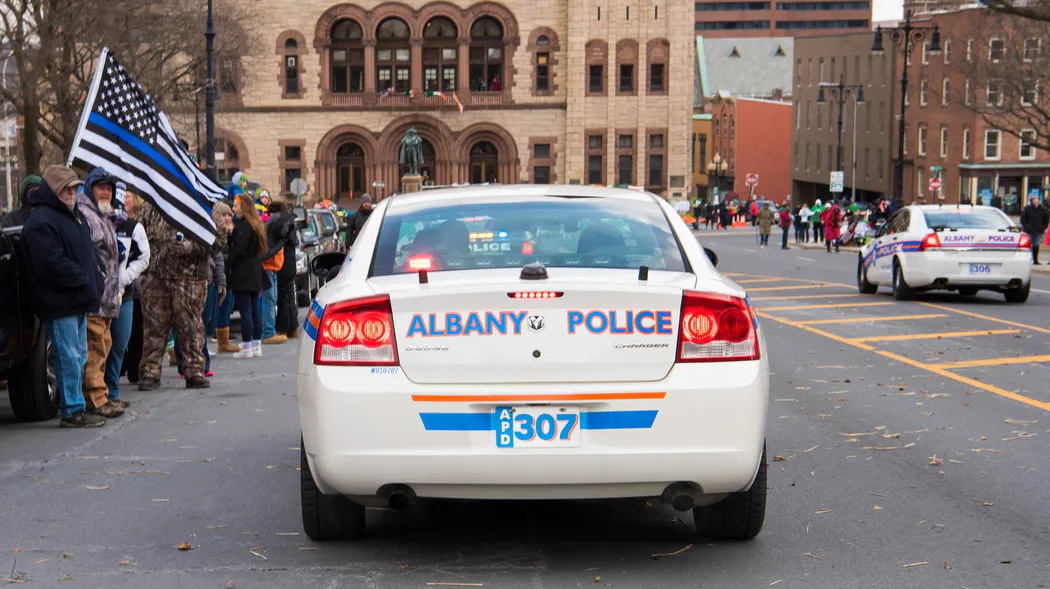Albany, Schenectady, Troy and other cities in the state’s Capital Region are spending more than ever on their police departments, citing retirements, rising crime and the need to bolster community policing units.
November 29, 2021 – By Pete DeMola – Source Times Union, Albany, N.Y.
ALBANY, NY—The slayings of George Floyd and Breonna Taylor at the hands of police sparked a year of activism and gave birth to a new phrase that entered the national lexicon:
“Defund the police,” a catchall term that broadly refers to taking funds from police departments and steering the money to alternative forms of public safety that don’t require a law enforcement response, including mental health calls.
Racial justice activists have been unrelenting in their demands to reallocate funding over the past 18 months.
Yet as municipal spending plans fell into place this fall, even the region’s most heavily Democratic cities have left police spending unchanged, including Albany, Schenectady, Troy and Saratoga Springs.
Cities are spending more than ever on their police departments, citing waves of retirements, rising crime, increasing equipment costs and the need to bolster community policing units, an outcome of the state-mandated reform process that ordered police departments to tweak operations based on community feedback.
The Albany Police Department’s budget was $54.7 million in 2020, constituting 30 percent of total general fund allocations.
Police spending rose to $55 million the following year, and the 2022 budget adopted by lawmakers earlier this month boosted allocations to $56.4 million — a 2.4 percent increase.
Not only did spending increase, but Albany police invested in new programming, hiring a “large group” of telecommunication specialists and increasing the size of the department’s motorcycle unit.
City Hall and Albany Police Department did not respond to multiple requests for comment to discuss the expenditures.
Police spending in Saratoga Springs was $9.2 million in 2020, or about 19 percent of total expenditures. Numbers dipped slightly the following year to $8.5 million but rose to $10.1 million in the 2022 spending plan, a 19 percent increase.
The increase is due to employee contract increases, state retirement cost contributions and health care benefits, as well as vehicle and equipment upgrades for the 71-member force, said city Finance Commissioner Michele Madigan.
In many places, the coronavirus crisis required extra police oversight, efforts and time but police forces have also benefited from federal COVID-19 relief monies.
There were no requests that would have shuttled police dollars to social services agencies, a key demand of activists.
“Essentially, this would take a big shift in how we allocate revenue,” Madigan said, noting the county is the government arm that receives funding for social services through the state and, sometimes, federal government.
While municipalities are spending more on their police departments, most experts agree that the defund slogan has also yielded a more team-oriented approach to emergency calls involving people struggling with mental illness or the homeless that police are sometimes ill-equipped to handle.
It’s a trend echoed across the nation, including in Minneapolis where a police officer murdered George Floyd on camera as other officers stood by. Despite outrage over Floyd’s killing, voters rejected a ballot measure that would have dismantled the Minnesota city’s police department and replaced it with a new unit focusing on public health.
In Washington, the Biden administration has shown little desire to prioritize a nationwide agenda of police reforms.
The U.S. Justice Department announced earlier this month it’s giving $139 million to police departments across the U.S. as part of a grant program to hire 1,000 new officers. Schenectady was among the cities who applied and is awaiting word if they will be receive money that will cover 15 new officers Police Chief Eric Clifford requested as part of the city’s police reform process.
Troy and Schenectady fully funded their police departments
The Rev. Nicolle Harris, head of the Schenectady NAACP chapter, said defunding or reallocating of funds to programs would help everyone.
“But we (community organizers) have been unable to articulate that because of the misunderstanding on both sides,” Harris said.
Harris, pastor of Duryee Memorial AME Zion Church in Schenectady, said part of the challenge behind the call for deep-seated changes to the criminal justice system is that the “defund and dismantle” model would likely adversely impact safety.
The 2022 budget the Schenectady City Council adopted earlier this fall would spend nearly $2 million more than what the city spent on policing in 2020. That year, the city budgeted $19.9 million for its police department. There was a modest increase to $20.1 million in this year’s spending plan before lawmakers settled on $22.8 million for next year.
Clifford called stripping money out of public safety to solve social problems “short-sighted.”
Residents of the most marginalized communities need services to prosper, he said.
“They need safety and they’re going to call the police if they don’t feel safe,” Clifford said.
There’s a direct link between the rise in the number of homeless calls the department has responded to over the years and the concentration of outpatient clinics located in Schenectady, Clifford said.
“My point with this is that you say ‘defund the police,’ but if anything, you’re going to have to fund these mental health counselors and probably give the police more funding to go with them to calls because those types of calls will last longer where the crisis worker will be on scene doing the assessment rather than the police officer going and getting the person and bringing them to a facility,” Clifford said.
“Clearly I don’t like the words ‘defund the police.’ However, to look at things from a positive perspective, that whole campaign has actually helped the police more than hurt them.”
It’s a sentiment echoed by Schenectady’s police reform panel, where the majority of participants reaffirmed the need for policing for public safety, while at the same time endorsing incremental changes designed to make police more accountable.
Activists are disheartened at the rising costs.
“I don’t think it’s not without malice and I don’t think it’s done with the best interest of the community,” said Saratoga Black Lives Matter leader Lexis Figuereo. “We say defund the police, and they say refund the police.”
Part of the budgetary increase in Saratoga Springs is to bankroll four new officers, a move officials contend is designed to help stamp out a spike in downtown violence.
Each position carries a price tag of $53,941.00 — not including benefits.
Figuereo questions the overall impact in crime reduction, noting officers didn’t prevent a brawl and a stabbing over Halloween weekend that injured four, crimes that remain unsolved.
“There were a bunch of officers on that night, and not one officer was there to intervene,” Figuereo said.
Figuereo called for funds to be boosted for homeless services, including increasing the number of Code Blue shelters designed to house people during freezing weather.
“We’re going to keep fighting for the reallocation of funds for community needs, community events and community boards,” Figuereo said.
University at Albany professor Carmen Montano argued that part of the problem is that the defund movement “means many things to many people.”
“My concern is that those that are on the more conservative side have done a better job of co-opting the term to stymie the conversation,” he said. “If we’re going to use the phrase, it has to be — I would like to think — within a broader context. … I understand it and respect the call for it, but now what do we do, what’s the transition?”
Matthew Ingram, who also teaches at UAlbany and focuses on justice issues, said the term has a tendency to alienate potential allies and has allowed opponents of police reform to paint those advocating for reform as extremists.
“I think we can talk about alternatives to policing or co-responder models or taking some of the extra things that we’ve asked police to do and put them in the hands of people who are better trained or perhaps more capable to do things with police acting as backup,” said Ingram, a former probation officer and police officer in California who currently is a member of the Albany Community Police Review Board.
Ingram touted Albany’s community-oriented policing initiative.
“The way I’m thinking about community-oriented policing is not so much putting more police out on the streets in close contact with the community but taking the community seriously as a partner in identifying problems and proposing solutions,” he said.
Troy Assistant Chief Steven Barker said that the defund campaign has also forced police departments to refocus efforts to build back relationships with citizens, often in communities of color where the mistrust of law enforcement sometimes runs deep.
For the past few months, Barker said, Troy has deployed patrol officers in crime hotspots “with solely communication in mind.”
“We sent them out with a whole command center, and said listen there’s no enforcement here, go out and meet people,” said Barker.
As far as spending, Troy budgeted $21.4 million for policing in 2021, an amount that includes the cost of health care and retirements. The budget proposal for 2022 increased police department spending to $22.8 million. Troy’s City Council is expected to adopt Mayor Patrick Madden’s proposed spending plan on Tuesday.
Back in Saratoga Springs, Madigan pointed to multiple partnerships with organizations aiding the homeless and said the city funds numerous nonprofits annually and a new grant program poised to launch next year will build upon those efforts.
Several cities have granted greater power and funding to civilian police oversight panels. Albany voters authorized giving the Community Police Review Board broader powers at the polls earlier this month, with lawmakers doubling funding from $246,000 to $560,000 annually, or 1 percent of annual police spending.
Saratoga Springs is in the process of forming an oversight panel, but its creation has been met with objection from activists, who have criticized the lack of subpoena power and the selection process for members, who will be appointed by the mayor.
Harris, the Schenectady pastor, said “creating a safer community is not just in the hands of police” but needs to revolve around affordable housing, adequate social services, mental health resources and good schools in order to to be prosperous.
“I don’t think that hiring more police has necessarily worked in the past and I don’t think that it’s necessarily going to work right now,” Harris said.
“I think we need to look at the bigger picture of what is it that Schenectady or Albany or Troy, what resources do we need to make these communities safer, I think that we perhaps need to look outside of the police department at what would make us safer.”
(c)2021 the Times Union (Albany, N.Y.)
Visit the Times Union (Albany, N.Y.) at www.timesunion.com
Distributed by Tribune Content Agency, LLC.

